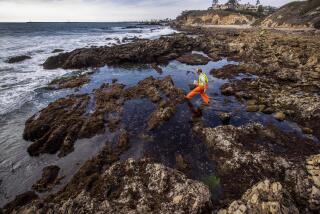Bracing for a Major Spill : County Officials Push for Details on Thousands of Hazardous Substances Trucked Daily in Area; Information Vital in Event of Serious Accident
Thousands of hazardous substances are transported through Orange County on any given day, according to state and local officials, but those charged with protecting the public from spills say they don’t have the information they need to plan for emergencies.
“We don’t know if we’re capable of responding adequately to an accident because we don’t know the magnitude of some of these shipments,” said Hugh Wood, director of Orange County’s hazardous materials program.
Transportation of hazardous materials has drawn widespread attention among government officials recently after disclosures of shipments of cryogenic fluorine through Orange County and rocket fuel through Los Angeles County. Since 1982, six shipments of cryogenic fluorine, owned by the Air Force, have been trucked on local freeways through the heart of Orange County to a lab in San Clemente.
Fluorine, chemists say, is one of the most dangerous substances known, and a spill could require an immediate evacuation within 3.9 miles. A major spill could dissolve asphalt freeway lanes and spread clouds of lethal fumes. Yet local authorities say they are given no information on when or where trucks carrying fluorine are crossing the county.
In an attempt to fill the information vacuum, the Board of Supervisors has asked Wood and other county officials to determine immediately whether the county’s emergency response teams are capable of handling hazardous materials in a serious accident. But that has proved to be a frustrating assignment.
“Nobody can put their hands or fingertips on any information, since shippers don’t have to tell anyone what they’re doing. . . . All you can do is go with what you’ve experienced with accidents in the past,” said Wood.
Kent Milton, spokesman for the California Highway Patrol, the agency responsible for licensing haulers of hazardous materials, said: “There’s no requirement that any shipper report, so we can only speculate.”
Nonetheless, Milton said, it is evident that thousands of hazardous substances are being shipped on county freeways every day. Trucking firms that haul hazardous materials are required by state and federal law to clearly mark shipments with standardized placards. That allows hazardous materials teams to assess the danger immediately upon arriving at the site of a spill, but it does not help them plan for potential emergencies.
The quantities of hazardous substances being shipped are startling.
“We think that about two-thirds of all the general freight being hauled at this time is classified as hazardous materials,” said Elmer Brown, director of government relations for the California Trucking Assn., an industry trade group.
State and federal agencies list about 10,000 substances as hazardous. Federal regulations define a hazardous material as a substance the government has decided can pose “unreasonable risk to health, safety and property when transported in commerce, and which has been so designated.”
In a report late last year by the California Department of Transportation, Caltrans said there were 342 reported incidents of hazardous material spills or leaks on state highways in fiscal 1984-85.
“Considering the volume of hazardous materials transported in California, these incidents and accidents are relatively infrequent . . . (but) due to the hazardous nature of the materials being transported . . . even one incident or accident could result in catastrophic consequences to people and property,” the report said.
Talcum Powder on Lists
Everything from rocket fuel to talcum powder is on state or federal lists of hazardous materials, said Karen E. Rasmussen, spokeswoman for the trucking association. Talcum powder is listed because a large bulk shipment could produce explosive dust.
“Rocket fuel is no more dangerous than a lot of other things we’re carrying up and down the roads,” said Michael J. Donahue, operations manager at U.S. Services Inc., a Corona hazardous waste trucking firm.
Hazardous wastes, composed primarily of dangerous by-products of manufacturing processes, are subject to special regulations governing packing, shipping and disposal that do not apply to haulers of hazardous materials.
The Legislature has given shippers of hazardous materials so much leeway in choosing their own routes that even substances manufactured as explosives--such as dynamite, rocket fuel, nitroglycerin and black powder--are approved for shipment on any freeway in Orange County.
On Jan. 1, a new section of the California Motor Vehicle Code that expressly empowers the CHP to designate routes for hazardous materials took effect. But CHP spokesman Milton said the agency has not yet used the new section, in part because of a long list of conditions in the law that are difficult to meet.
Before a route can be banned, for example, the code requires the CHP to determine that the route is less safe than an alternative highway and that the change will not eliminate necessary access to local pickup or delivery points and does not eliminate reasonable access to fuel, repairs, rest or food facilities. There are another dozen conditions.
According to Milton, the CHP has licensed about 6,725 hazardous materials haulers, all but a few of whom renew annually. License applicants must pass a CHP safety inspection and be insured for about $1 million to cover the costs of cleaning up spills. Only two licenses have been revoked or suspended in the past three years, and Milton said he could not immediately identify the license holders or the reason for disciplinary action against them.
Caltrans was not required to report to the Legislature on the use of state highways for hauling hazardous materials until last year. In 1985, the Legislature passed a bill calling for a one-time report on the subject.
In that report, dated last September, Caltrans estimated that 170 million tons of hazardous materials are shipped annually throughout the state. According to the report, the shipments involved about 72,000 carloads on rail lines, and “between 4 and 5 million truckloads” per year.
Only Ballpark Figures
But the report cautioned that these are only ballpark figures.
“At best, existing data are sufficient only for rough estimates,” the report stated. “They are by no means adequate for risk assessments or risk comparisons.”
Caltrans’ figures did not include shipments by pipeline.
There were 61 incidents of hazardous material spills or leaking tank cars involving rail shipments statewide in 1985, the report states, plus “seven reported derailments and/or fires.”
The 342 incidents of hazardous material spills or leaks on state highways in fiscal 1984-85 included four fires and 19 overturned vehicles.
“The primary cause of highway incidents and accidents involving vehicles carrying hazardous materials is human error,” according to the Caltrans report.
The news media often distort the actual danger, said Doug Schnick, Anaheim representative of Beall Trans-Liner Inc., a tanker manufacturing firm in Portland, Ore.
Most of the hazardous materials are either packed in containers and shipped in ordinary trucks or are put into aluminum or steel tankers, said truckers and equipment makers. Very little explosive or highly toxic material--the kind that would require cryogenic tankers--is shipped, they said.
Cryogenic tankers are designed to hold gases and liquids that become highly volatile if they are not kept at certain temperatures. As few as three equipment manufacturers even make cryogenic tankers, and those are out-of-state companies, Schnick said.
Some companies that use highly explosive materials, such as TRW Systems Group in San Clemente, require only small amounts. A TRW spokeswoman said the cryogenic fluorine that the company uses in laser research has been shipped about once a year by the Air Force, which retains ownership of the material even while it is stored at the TRW facility.
A 1984 state law requiring that more stringent standards be set up for drivers hauling hazardous materials hasn’t been implemented, Rasmussen said.
The Department of Motor Vehicles, which is charged under the law with drawing up those standards and determining how they are to be imposed, threw out its first draft in the face of tremendous opposition at a public hearing.
By the time its second version won state administrative approval, Congress had adopted national standards for commercial drivers. Now, the U.S. Department of Transportation is reviewing the state’s version for possible conflicts with the federal standards, Rasmussen said.
Plans Legislation
State Sen. John Seymour (R-Anaheim), who sponsored the 1984 bill, said he plans to introduce legislation in January to beef up safety inspections on all trucks and require more safety features for those vehicles carrying dangerous products.
“We really do not know what’s out there, and that’s what makes it so scary,” Seymour said. “It’s also scary because the rigs are bigger and more sophisticated. You combine that with the additional traffic our highways are handling, and you’ve got an accident waiting to happen.”
Trucking firms certainly want strict driver standards, said Donahue of U.S. Services Inc. He said he would even lobby for a national driver’s license for commercial drivers, an issue federal lawmakers discussed but declined to include in legislation.
“People often don’t know the difference among haulers, and we get thrown into the same boat with those hauling rocket fuel or hazardous waste,” said Edward Wada, president of East West Lines, a Montebello petroleum hauler.
But Wada said every hauler of hazardous materials must be cautious, no matter how dangerous any particular product might be.
“The very nature of gasoline is one in which you have to use extreme care,” he said. “If we didn’t, we wouldn’t be in business.”
More to Read
Start your day right
Sign up for Essential California for news, features and recommendations from the L.A. Times and beyond in your inbox six days a week.
You may occasionally receive promotional content from the Los Angeles Times.





